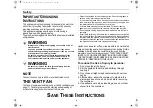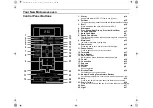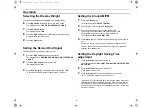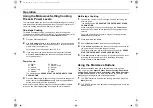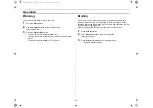
4
S
AVE
T
HESE
I
NSTRUCTIONS
Safety
I
MPORTANT
G
ROUNDING
I
NSTRUCTIONS
This appliance must be grounded. In the event of an electrical
short circuit, grounding reduces the risk of electric shock by
providing an escape wire for the electric current.
This appliance is equipped with a power cord having a
grounding wire with a grounding plug.
The plug must be plugged into an outlet that is properly installed
and grounded.
WARNING
Improper use of the grounding plug can result in a risk of
electric shock.
Consult a qualified electrician or servicer if you do not
understand the grounding instructions or if you are not sure
if the appliance is properly grounded.
Do not use an extension cord with this appliance. If the
power cord is too short, have a qualified electrician or
service technician install an outlet near the appliance.
WARNING
Do not cut or remove the third (ground) prong from the
power cord under any circumstances.
NOTE
Connect the oven only to a 20A or over dedicated circuit.
THE VENT FAN
The fan will operate automatically under certain conditions (see
page 17).Take care to prevent the starting and spreading of
accidental cooking fires while the vent fan is in use.
• Clean the underside of the microwave often. Do not allow grease to
build up on the microwave or the fan filters.
• In the event of a grease fire on the surface units below the microwave
oven, smother a flaming pan on the surface unit by covering the pan
completely with a lid, a cookie sheet or a flat tray.
• Use care when cleaning the vent fan filters. Corrosive cleaning
agents, such as lye-based oven cleaners, may damage the filters.
• Do not prepare flaming foods under the microwave when the fan is
operating.
• Never leave surface units beneath your microwave oven unattended
at high heat settings. Boilovers cause smoking and greasy spillovers
that may ignite and spread if the microwave vent fan is operating. To
minimize automatic fan operation, use adequate sized cookware and
use high heat on surface units only when necessary.
Liquids, such as water, coffee, or tea are able to be overheated
beyond the boiling point without appearing to be boiling. Visible
bubbling or boiling when the container is removed from the
microwave oven is not always present. THIS COULD RESULT
IN VERY HOT LIQUIDS SUDDENLY BOILING OVER WHEN
THE CONTAINER IS DISTURBED OR A SPOON OR OTHER
UTENSIL IS INSERTED INTO THE LIQUID.
To reduce the risk of injury to persons:
1. Do not overheat the liquid.
2. Stir the liquid both before and halfway through
heating it.
3. Do not use straight-sided containers with narrow
necks.
4. After heating, allow the container to stand in the
microwave oven for a short time before removing
the container.
5. Use extreme care when inserting a spoon or other
utensil into the container.
zt}`X]\zjUGGwG[GG{ SGhGY`SGYWWZGG`aWZGwt




